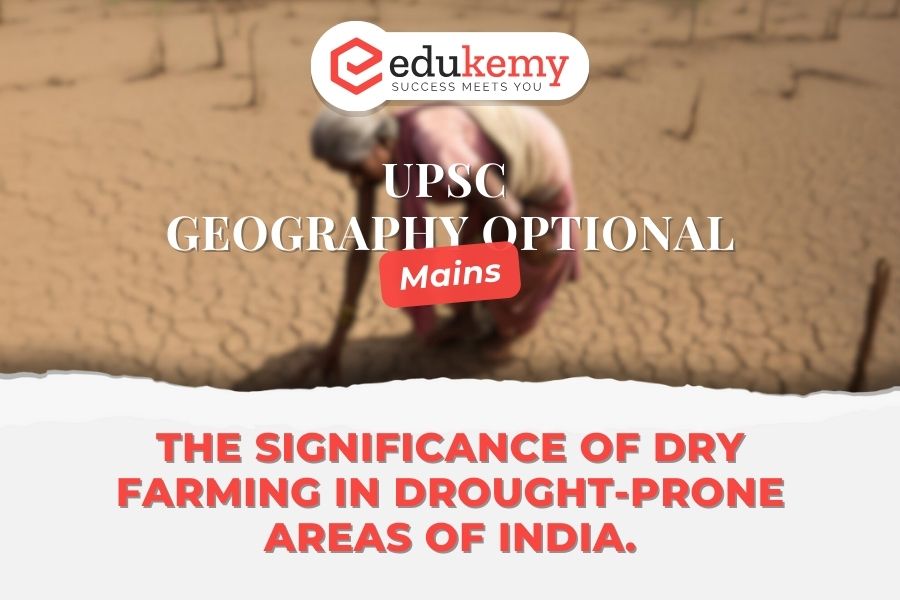
Discover the importance of dry farming in India’s drought-prone regions. Explore how this traditional agricultural method conserves soil moisture and maximizes crop yield under water-scarce conditions. Understand its reliance on indigenous practices such as soil conservation, crop rotation, and moisture-retaining techniques. Delve into the socio-economic significance of dry farming, providing livelihood security and food sovereignty to rural communities. Uncover its role in enhancing resilience against climate variability and mitigating the impacts of recurrent droughts. Gain insights into the sustainable farming practices adopted by farmers to adapt to arid environments, ensuring food security and environmental sustainability. Explore the enduring relevance of dry farming in addressing the challenges of water scarcity and climate change in India’s dryland regions.
Contents
Answer:
Introduction:
Dry farming is an agricultural technique that relies on natural precipitation for crop growth, without the use of irrigation. It involves techniques such as soil conservation, crop rotation, and moisture-retaining practices to make the most of limited water resources.
Body:

Signficance of dry farming in drought prone areas of India.
- Water Conservation: Dry farming helps conserve water by utilizing rainfall efficiently, making it crucial in drought-prone regions like parts of Maharashtra and Rajasthan.
- For instance, in regions like Vidarbha, where water scarcity is common, dry farming techniques allow farmers to cultivate crops like jowar and bajra even during dry spells.
- Soil Health: Dry farming practices improve soil health by reducing erosion and increasing organic matter content. Techniques like mulching and cover cropping help maintain soil structure and fertility, ensuring sustainable agriculture in the long term.
- This is particularly significant in areas like the Deccan Plateau, where soil erosion is a major concern.
- Crop Diversity: Dry farming encourages the cultivation of drought-resistant crops, diversifying agricultural production. This diversification enhances food security and reduces dependence on water-intensive crops.
- For example, farmers in Gujarat’s Kutch region practice dry farming of pulses like chickpeas and lentils, which are well-suited to arid conditions.
- Economic Stability: By reducing reliance on irrigation and expensive inputs, dry farming promotes economic stability among smallholder farmers.
- In regions like Bundelkhand, where erratic rainfall patterns and water scarcity affect traditional farming practices, adopting dry farming methods allows farmers to mitigate risks and maintain livelihoods.
- Climate Resilience: Dry farming builds resilience to climate change by adapting to changing precipitation patterns and water availability.
- In states like Karnataka’s North Karnataka region, where frequent droughts challenge agricultural productivity, adopting dry farming techniques such as contour plowing and rainwater harvesting helps farmers cope with climate variability.
- Sustainable Agriculture: Dry farming promotes sustainable agriculture by minimizing water usage and environmental impact.
- In regions like Andhra Pradesh’s Rayalaseema district, where water resources are limited, practices like intercropping and agroforestry under dry farming systems improve land productivity while conserving water resources for future generations.
- Indigenous Knowledge: Dry farming incorporates indigenous knowledge and traditional farming practices that are well-suited to local environmental conditions.
- For example, in parts of Tamil Nadu’s Sivaganga district, farmers rely on centuries-old techniques such as terracing and bunding to capture and retain rainfall, ensuring consistent crop yields even in drought years.
- Policy Support: Government policies and initiatives support the adoption of dry farming practices in drought-prone areas, providing subsidies, technical assistance, and infrastructure development.
- Initiatives like the National Mission for Sustainable Agriculture (NMSA) promote dry farming as a viable strategy for enhancing agricultural resilience and rural development.
Conclusion:
By promoting water conservation, soil health, crop diversity, and economic stability, dry farming offers a sustainable pathway towards climate-resilient agriculture. However, concerted efforts are needed to further promote and support the adoption of dry farming practices through policy incentives, research, and capacity building to ensure food security and livelihood sustainability in drought-prone regions.
In case you still have your doubts, contact us on 9811333901.
For UPSC Prelims Resources, Click here
For Daily Updates and Study Material:
Join our Telegram Channel – Edukemy for IAS
- 1. Learn through Videos – here
- 2. Be Exam Ready by Practicing Daily MCQs – here
- 3. Daily Newsletter – Get all your Current Affairs Covered – here
- 4. Mains Answer Writing Practice – here

